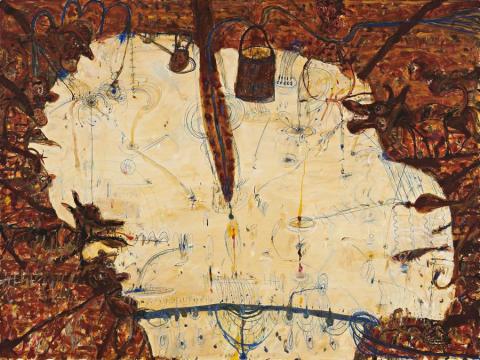WATER FLOWING INTO LAKE EYRE, 1992
JOHN OLSEN
oil on canvas
182.0 x 244.0 cm
signed and dated lower right: John Olsen 92 inscribed verso: WATER FLOWING INTO. L. EYRE.
Sherman Galleries, Sydney
Gene and Brian Sherman collection, Sydney,
acquired from the above in 1998
The Rose Crossing: Contemporary Art in Australia, Brisbane City Gallery, Brisbane, 8 September – 23 October 1999; Hong Kong Arts Centre, China, 29 November – 20 December 1999; Singapore Art Museum, Singapore, 10 February – 28 March 2000; Holmes à Court Gallery, Perth, 29 April – 29 May 2000; then touring to S.H. Ervin Gallery, Sydney and Campbelltown City Bicentennial Art Gallery, Campbelltown, 2000
For many artists, there is a motif to which they return at numerous points in their career, reinterpreting and drawing new inspiration. For Sidney Nolan, it was Ned Kelly; for Paul Cezanne, Mont Sainte-Victoire. For John Olsen, the motif is Lake Eyre. Its significance is such that Patrick McCaughey has described it as being central to 'four decades of Olsen's Dreaming'.1 'I've been nearly drowned on the blessed lake when our boat sank in a sudden storm; nearly been sucked under by the quicksand-like treacherous black mud; nearly been blown away by winds that howl in at midnight, buffeting your tent; I've had desert sand blow into my eyes, my paint, the camp oven, and ruin my beautiful fish paellas ... but all in all, I've had a fabulous time there.'2
Located 700 kilometres north of Adelaide, Olsen first visited Lake Eyre in October 1974 in the company of naturalist Vincent Serventy. They had journeyed to see the lake's largest flood in 500 years, an experience which profoundly affected the artist's way of interpreting his world. 'The lake might be viewed as an unconscious plughole of Australia, a mental landscape... Because it is 13 metres below sea level - and perhaps nowhere in Australia does one have the feeling of such complete emptiness - covered by a bowl of endless sky with inviting silences, there is, as you stand on the edge of the lake, a feeling that you are standing on the edge of a void.'3 One of the first paintings inspired by this encounter was Arrival at the Void, 1975, and many subsequent, related works bear the word in their title.
Like the artist Ian Fairweather, who he greatly admired, Olsen was fascinated by Chinese art and literature. With Water Flowing into Lake Eyre, he presents a perfect encapsulation of their interpretation of the void as evoking the concept of 'everything and nothingness', 'a place for contemplation, a vast, engulfing space.'4 In this painting, the vision literally pops and fizzes with life. Set on a highly tilted plane that may be viewed on a macro- and micro- level, the edges teem with life as water skimmers leave arcs on the surface like the trails behind Brett Whiteley's ferries. Dingoes, birds and humans gather by the shore whilst a patterned python bisects the sand as it stretches out to take a drink. 'There's a lot happening in my pictures. I take a multi-perspective approach on the one canvas, I'm down on the ground one moment and up flying the next, or looking sideways or underneath, because that's the way the world is today.'5
1. McCaughey, P., Why Australian Painting Matters, The Miegunyah Press and Text Publishing, Melbourne, 2014, p. 236
2. Hawley, J., 'John Olsen', Encounters with Australian Artists, University of Queensland Press, Queensland, 1993, p. 134
3. Olsen, J., 1975. Quoted in Hart, D, John Olsen, Craftsman House, Sydney, 2000 (revised edition), p. 133
4. Hart, D., ibid., p. 135
5. Janet Hawley, 'John Olsen', Encounters with Australian Artists, op. cit., p. 129
ANDREW GAYNOR
